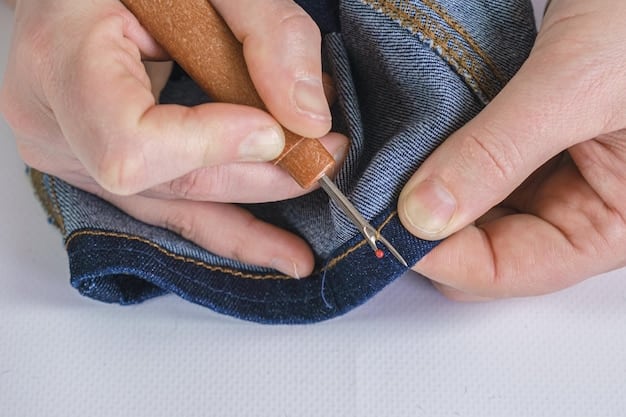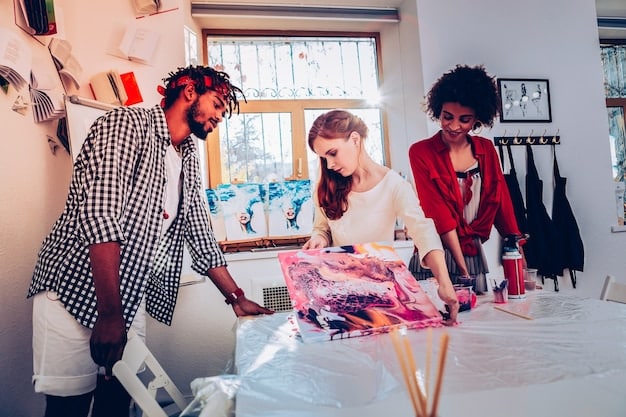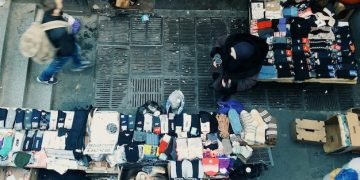Underground Fashion’s Ethical Dilemma: Sustainability vs. Creativity

Underground fashion faces an ethical dilemma, striving to balance creative expression with sustainable practices, pushing for eco-conscious innovation within alternative styles.
The world of fashion is constantly evolving, with each passing season bringing new trends and styles. But beyond the glossy runways and high-end boutiques lies a vibrant and often overlooked subculture: underground fashion’s ethical dilemma: balancing creativity and sustainability. This movement, characterized by its rejection of mainstream aesthetics and embrace of individuality, faces a unique challenge: how to maintain its creative edge while adhering to ethical and sustainable principles.
Understanding Underground Fashion
Underground fashion isn’t just about wearing different clothes; it’s a statement, a form of self-expression, and often a rebellion against the status quo. But what exactly defines this dynamic realm, and how did it emerge?
This subculture encompasses a diverse range of styles, from punk and goth to alternative streetwear and avant-garde designs. Each style carries its own distinct aesthetic and philosophy, but they are all united by a common thread: a desire to challenge conventional norms and express individuality through clothing.
The Roots of Rebellion
Underground fashion’s origins can be traced back to various countercultural movements throughout history. From the punks of the 1970s, who ripped andSafety-pinned their clothes as a sign of anti-establishment sentiment, to the goths of the 1980s, who embraced dark aesthetics to challenge mainstream notions of beauty, underground fashion has always been a way for people to express their dissent and carve out their own identity.
Key Characteristics
- Individuality: Emphasizing unique self-expression over mainstream trends.
- DIY Ethos: A strong preference for handmade, upcycled, or customized garments.
- Rejection of Consumerism: Countering fast fashion and promoting ethical consumption.
- Community Focus: Building connections through shared aesthetic and values.
In essence, understanding underground fashion means recognizing its role as a dynamic force that challenges norms and celebrates individuality.

The Rise of Ethical Concerns
As awareness of environmental and social issues grows, the fashion industry is facing increasing scrutiny. This has spurred a critical examination of the ethical implications of both mainstream and underground fashion practices. Let’s examine some of the key concerns.
Consumers and designers alike are waking up to the harsh realities of fast fashion. From the exploitation of garment workers to the pollution caused by textile production, the industry’s dirty secrets are becoming increasingly difficult to ignore.
Environmental Impact
The fashion industry is a major contributor to environmental degradation. The production of textiles requires vast amounts of water, energy, and chemicals, leading to pollution of waterways and depletion of natural resources. Fast fashion’s rapid turnover also results in massive amounts of textile waste, much of which ends up in landfills.
Social Justice Issues
Many fast fashion brands rely on factories in developing countries where garment workers are subjected to unsafe working conditions, long hours, and low wages. These workers, often women and children, are vulnerable to exploitation and abuse.
The Push for Change
Growing concerns about the ethical implications of fashion have fueled demand for sustainable and ethical alternatives. Consumers are increasingly seeking out brands that prioritize fair labor practices, eco-friendly materials, and transparent supply chains. This shift has prompted some underground fashion communities to adopt more sustainable practices.
The rise of ethical concerns is reshaping the fashion landscape, pushing both mainstream and underground communities to rethink their practices and embrace more responsible approaches.
Creativity vs. Responsibility
Balancing creativity with ethical responsibility is a delicate act, particularly in the realm of underground fashion. While the essence of underground fashion lies in breaking free from conventional norms and expressing unique visions, the ethical considerations demand a conscious effort to mitigate harm and promote positive change.
How can designers and consumers reconcile their artistic impulses with the need to address pressing issues like waste, exploitation, and environmental degradation? This is one of the critical questions of our time.
Upcycling and Repurposing
Many underground designers are turning to upcycling and repurposing as a way to create unique and sustainable garments. By transforming discarded materials into new creations, they reduce waste and give new life to items that would otherwise end up in landfills.
Local and Small-Scale Production
Supporting local designers and small-scale production is another way to promote ethical fashion. By buying directly from independent artists and craftspeople, consumers can ensure that their money is going to support fair labor practices and sustainable production methods.
Transparency and Education
Promoting transparency and educating consumers about the ethical implications of their purchasing decisions is crucial. Brands can provide detailed information about their supply chains, labor practices, and environmental impact, empowering consumers to make informed choices.
Ultimately, balancing creativity with responsibility requires a willingness to challenge conventional norms, embrace innovation, and prioritize ethical considerations at every stage of the design and production process.

Sustainable Materials and Practices in Underground Fashion
One of the most significant shifts towards ethical responsibility in underground fashion is the adoption of sustainable materials and practices. This entails a departure from conventional textiles and methods, embracing alternatives that minimize environmental impact and promote social well-being.
Sustainable materials and practices not only reduce harm but also foster innovation and creativity, driving the evolution of underground fashion into a more conscientious and imaginative space.
Organic and Recycled Fabrics
Designers are increasingly using organic cotton, hemp, and recycled polyester to create their garments. These materials have a lower environmental impact than conventionally produced textiles, reducing the reliance on pesticides, water, and fossil fuels.
Natural Dyes and Low-Impact Processes
Traditional dyeing processes often involve harsh chemicals that can pollute waterways and harm workers. Underground designers are exploring natural dyes derived from plants, minerals, and other sustainable sources. They are also adopting low-impact dyeing and finishing techniques that minimize pollution.
Zero-Waste Design
Zero-waste design is an approach that seeks to eliminate textile waste by carefully planning garment construction to utilize the entire fabric width. By minimizing scraps, designers can reduce the environmental impact of their creations.
The adoption of sustainable materials and practices represents a fundamental shift in the way underground fashion operates, paving the way for a more ethical and environmentally conscious industry.
The Role of the Consumer
Consumers play a critical role in driving the ethical transformation of the fashion industry. By making informed choices and supporting brands that prioritize sustainability and social responsibility, they can influence the industry’s direction.
The power of conscious consumerism lies in its ability to incentivize ethical practices and push for greater transparency and accountability throughout the fashion supply chain.
Supporting Ethical Brands
Seeking out and supporting brands that are committed to fair labor practices, eco-friendly materials, and transparent supply chains is a powerful way to promote ethical fashion. Look for certifications such as Fair Trade, GOTS (Global Organic Textile Standard), and Bluesign.
Buying Secondhand
Shopping for vintage and secondhand clothing is a great way to reduce waste and extend the life cycle of garments. Thrift stores, consignment shops, and online marketplaces offer a wide selection of unique and affordable items.
Caring for Clothes
Extending the life of clothing through proper care and maintenance is another way to reduce waste. Follow care instructions, repair damaged items, and consider donating or reselling clothes that no longer fit or are no longer worn.
Consumer choices have a ripple effect, incentivizing brands to adopt more ethical practices and creating a demand for sustainable alternatives.
The Future of Underground Fashion
As ethical awareness continues to grow, the future of underground fashion is intertwined with sustainability and social responsibility. The integration of innovative technologies, community collaborations, and redefined values positions the movement as a beacon for change.
The path forward involves embracing new models of production, consumption, and collaboration, fostering a fashion ecosystem that is both creative and conscientious.
Technological Innovations
Advancements in textile technology, such as lab-grown materials and 3D printing, can help to reduce the environmental impact of fashion. These innovations offer the potential to create sustainable and customized garments with minimal waste.
Community Collaborations
Collaborations between designers, artists, and activists can help to raise awareness about ethical issues and promote positive change. By working together, they can amplify their voices and reach a wider audience.
Redefining Values
The future of underground fashion requires a shift in values, prioritizing sustainability, social justice, and creativity. By reimagining the concept of fashion as a tool for positive change, the movement can inspire a more ethical and responsible industry.
The future of underground fashion depends on its ability to evolve and adapt, embracing innovation, collaboration, and a commitment to ethical principles.
| Key Point | Brief Description |
|---|---|
| ♻️ Sustainable Materials | Using organic, recycled, and upcycled materials reduces environmental impact. |
| 🤝 Ethical Labor | Supporting fair wages and safe working conditions for garment workers. |
| 🔄 Upcycling | Transforming discarded materials into new, unique fashion items. |
| 🛍️ Conscious Consumerism | Making informed purchasing decisions based on ethical and environmental considerations. |
Frequently Asked Questions
▼
Underground fashion is characterized by its rejection of mainstream trends, emphasis on individuality, DIY ethos, and counter-consumerist attitudes. It expresses unique self-expression over conventional norms.
▼
Sustainability addresses the environmental and social impacts of the fashion industry. Integrating sustainable practices makes underground fashion more responsible and aligns with its values of rebellion and awareness.
▼
Consumers can support ethical brands by looking for certifications like Fair Trade and GOTS, buying secondhand, caring for their clothes to extend their lifespan, and choosing brands that prioritize transparency.
▼
Sustainable materials include organic cotton, hemp, recycled polyester, and innovative fabrics like Tencel and Piñatex. These materials minimize environmental impact compared to conventional textiles. Look for natural dyes.
▼
Creativity drives innovation in ethical fashion by inspiring designers to find new ways to upcycle materials, use sustainable resources, and create unique designs that challenge conventional norms while minimizing environmental harm.
Conclusion
Navigating the ethical dilemma in underground fashion requires a balance between creative expression and sustainable responsibility. By embracing ethical materials, supporting fair labor practices, and fostering a culture of conscious consumerism, the underground fashion community can pave the way for a more sustainable and socially responsible industry.





